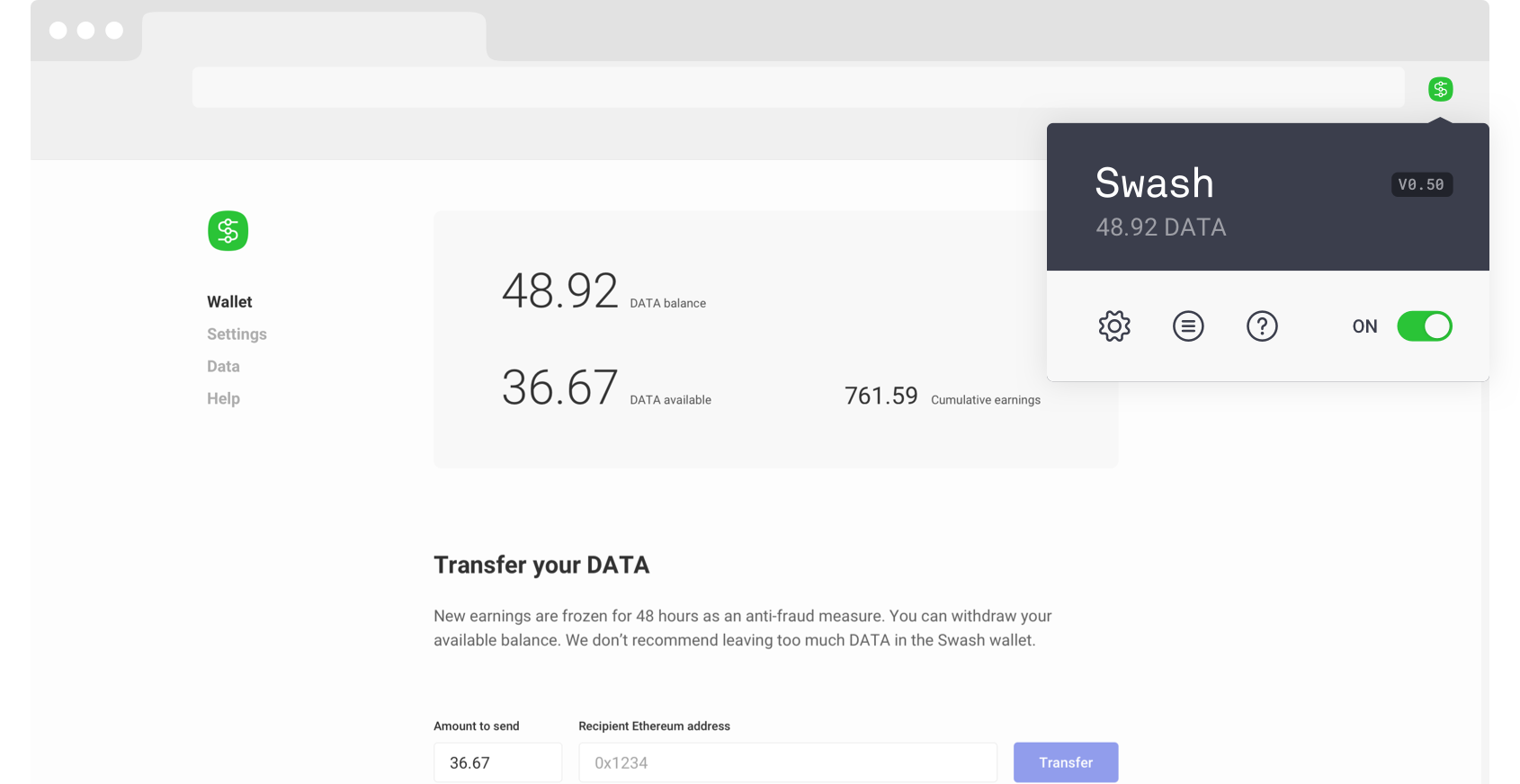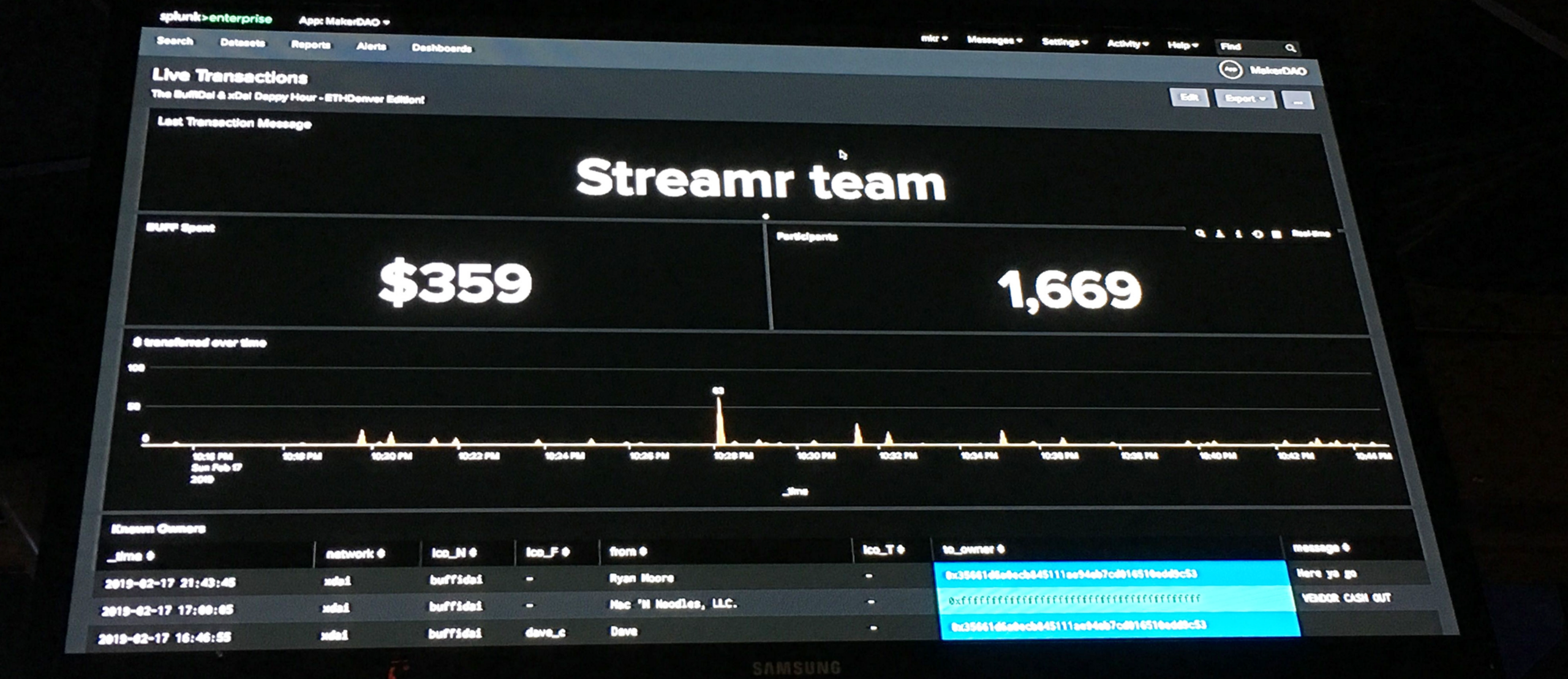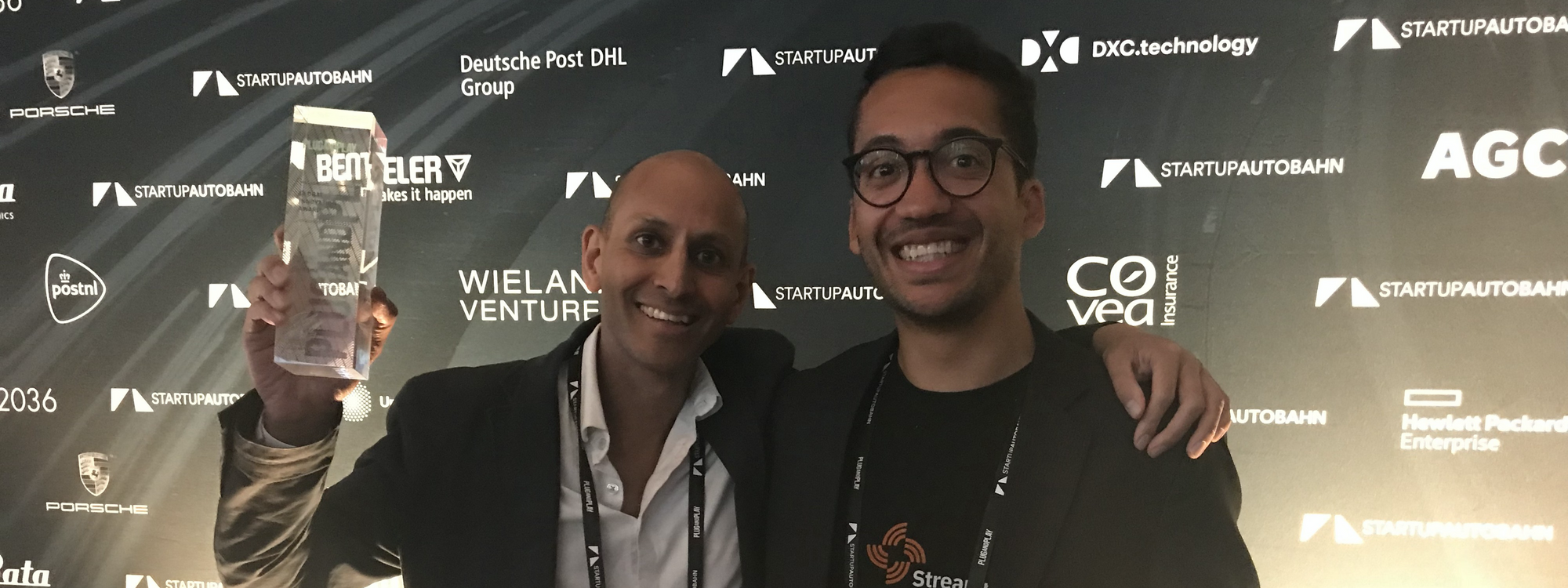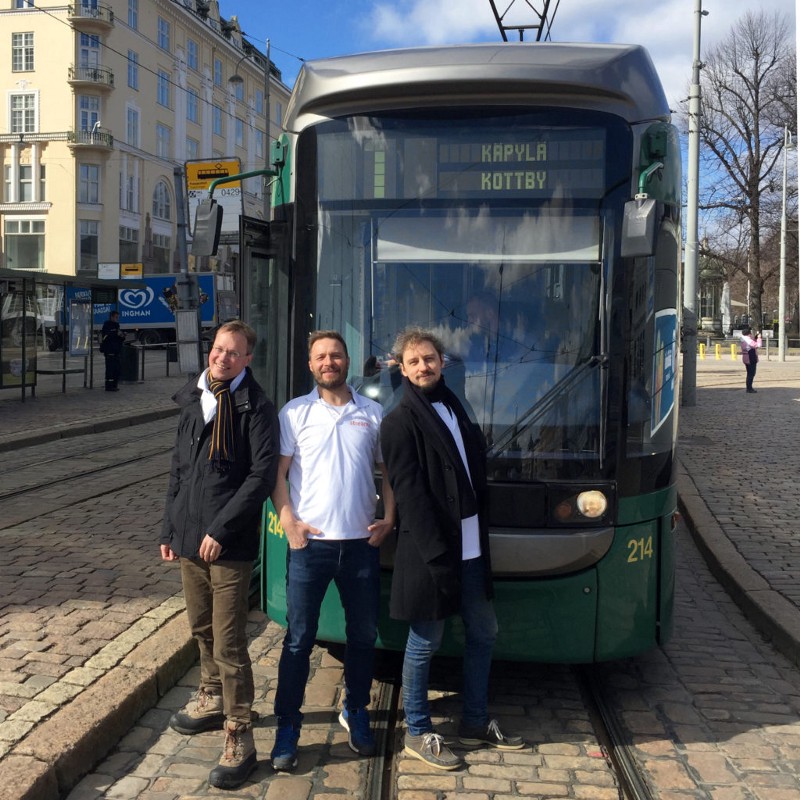
It was the summer of 2012 when we put our thinking hats on to try and solve a particular problem that was collectively driving us more than a bit mad: It was extremely difficult to build and even more so to test trading algorithms based on so-called “real world” data. United by our hard-won comfort in the adrenaline-soaked world of high-frequency trading, we thus decided to build a set of tools to make our lives easier. This was the first version of Streamr, born as a way to assemble and distribute low-latency data feeds, and to rapidly build models and algorithms which monitor and react to this data.
Fast-forward a few years, and the Internet of Things is beginning to emerge. From the earliest steps, we intuited that this was something important, that perhaps the whole world would, in its own way, be moving in the direction of trading and finance. After all, what is the point of so many sensors, if not to provide real-time data and “identify” signals on the fly? This would naturally lead to algorithms taking automatic action to grab those fleeting-but-profitable opportunities, for the benefit of both individuals and businesses. And we were far from wrong: streaming analytics is now growing into one of the hot topics in the software business.
So we built a business around real-time data and streaming analytics. We created a functional and scalable low-code SaaS platform where it is easy to develop and deploy real-time microservices. We’ve gathered up a number of good customers, and there are many fascinating use cases in development. But until now, something has been missing from the picture.
Our ultimate vision is that everyone is able to use our platform and tools, connecting real-time data sources to other popular services and platforms, generally performing magic to solve customer problems and even create totally new services. But to accomplish this, another layer is needed, which provides both community and a mechanism for trust.
By late 2016, our home town of Helsinki was a true hotbed of innovation and startup activity. When a long-time friend introduced us to some interesting characters in the blockchain community, a number of illuminating conversations transpired, and we found ourselves thinking out loud:
Hey, there’s this wonderful community of tech-minded people who have created a decentralised, trustless network where you can have immutable facts mined and set in stone (or the digital equivalent) for anyone to see. And there’s yet another protocol where you can have computer code run in the same decentralised, trustless fashion, and all it takes is something called “gas”.
Our minds were blown. It’s not that we hadn’t heard of Bitcoin, blockchain, Ethereum, and other related technologies before, but it took a bolt of lightning for the reality to fully click. We already knew how to work with real-time data, and how to make life easy for those developing algorithms on top of streaming data. But what if we applied this to a decentralised computing machine? Could we ultimately offer the world a trust-free service with easy access to a real world data, and a killer usability layer? And what, in fact, would that mean?
After sleepless days and nights coddling our brains while pondering the profound and almost magical ramifications, the missing piece of the puzzle indeed fell into place for us. We could build this. And since we are as excited about Ethereum as we have ever been about anything that we have seen, we intend to go “all out”, as they say. At EDCON in Paris this year, I got on stage, connected a smart contract to a live feed from Helsinki City public transport, and deployed the contract, all in 5 minutes or so. A simple pay-by-use demo on the Ethereum platform, all using existing Streamr tools. It was fun, we got lots of positive feedback and ideas, and made some fascinating new friends.
Here’s an embedded a video of the EDCON demo:
For those who didn’t make to Paris, let me first briefly recap what the demo is about. The action takes place in Helsinki, Finland, where each tram is equipped with a GPS receiver as well as sensors which measure the vehicle speed, heading, and many other quantities. Each tram transmits its location and the sensor readings to the public transport agency’s backend every second or so. The live data feed is available at no charge over the MQTT protocol to any company or developer out there.
Now imagine that you’re in charge of the public transport in Helsinki, and a decision has been made to outsource the running of the tram network to a third party. How do you set up a smart contract which automatically incentivises the tram operator for running a tight ship (if you forgive me the pun)?
After some thought, we decided that it’s best to keep things simple to start with. The city pays the operator incrementally based on mileage. A smart contract keeps track of the mileage run and makes the payments as the trams happily chug along. The demo shows how such a smart contract can be set up easily, connected to a live data feed, and deployed in the chain.
The demo touches on one important aspect of real-world data as input to a smart contract. In this use case — as in many others — the volume of streaming data is sufficiently large to overwhelm any blockchain. There’s simply too much data to feed everything in to a smart contract and have it processed by e.g. the Ethereum virtual machine.
What this means that some off-chain processing is needed. In the demo, we make use the Streamr platform where much of the required streaming analytics functionality is already built in. This is what we do:
- First we connect to the live data stream from the Helsinki transport agency (this is the MQTT feed from the trams).
- We visualize the live tram data on a module showing the city map with the live location of every tram. The purpose here is nothing but to make sure that the data looks sensible, and is something we can build on.
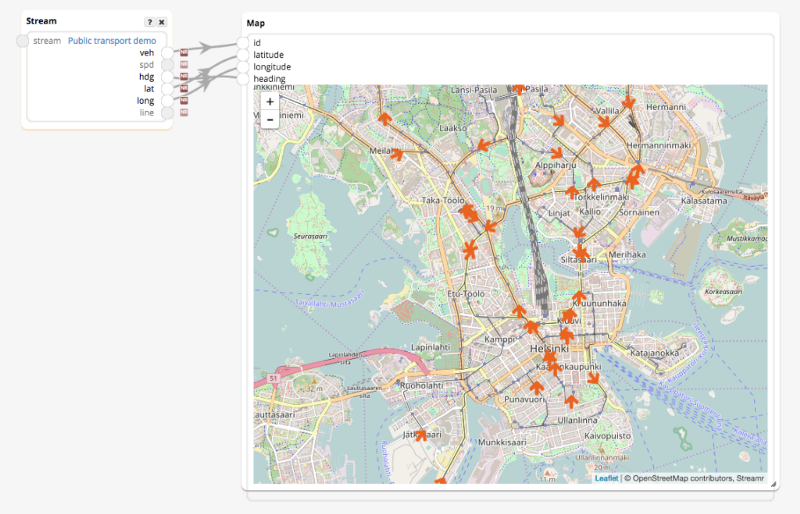
- Next we deploy the smart contract. Our aim is to build ready-made, reusable smart contract templates readily available in Streamr. Here, we’re using one called PayByUse. We can open the template code in a built-in Solidity editor in the Streamr front-end. The contract is initialized with information on whom to pay and how much (in wei) to pay per reported unit (traveled meter). When the process is running, a function called update will be called every once in a while to report usage to the smart contract, which calculates and makes the payments.
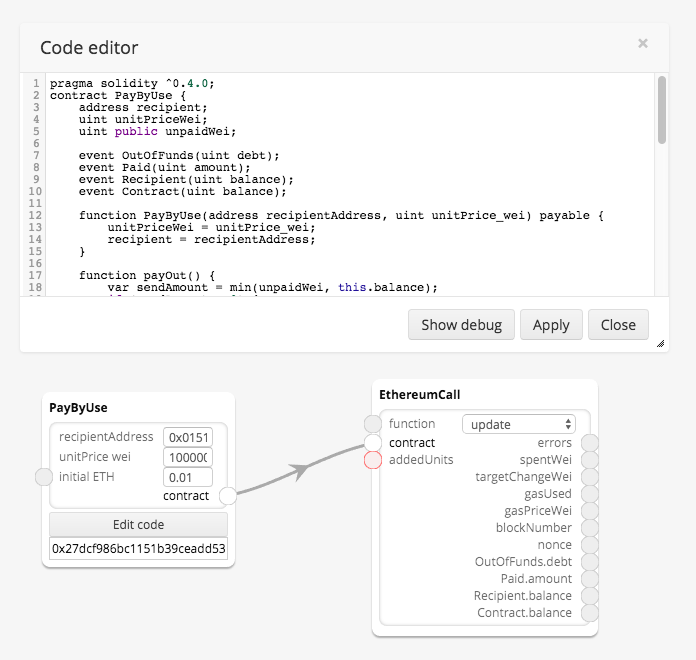
- We need to calculate the mileage run by each tram in the city. We get that done by calculating speed * delta time (equals distance, remember high-school physics?) from subsequent measurements for each tram. In the below image this is abstracted inside the ForEach module.
- As discussed above, we cannot feed in all the real-time data to the smart contract. What we do instead is to accumulate the little distance increments until a threshold (10.000 meters in this case) is reached, report that to the smart contract, and reset the accumulator back to zero. The contract makes the transaction where the agreed amount of wei is calculated and transferred to the tram operator every time the threshold is crossed.

- Now we’re pretty much done. Let’s save the workspace, press the start button, and see what happens. And voilà — the mileage starts accumulating, and as soon as a total of 10.000 meters is reached, update function call is made, and wei is transacted.
Below you can see a live Streamr Canvas (a workspace) with the above steps plus some visualisations added. It shows the actual real-time feed from the Helsinki city transport connected to a smart contract. You’re free to have a look, poke around, kick the tires. Note though that this demo connects to the Rinkeby testnet, and it doesn’t worry about things like secrecy (you’ll find the private key in there but please do not withdraw the ether, it will spoil the fun for all others😊).
You can also view the Canvas in our editor (requires free signup).
There’s of course many simplifications in here. In practise you’d want to take many other variables into account in the payment schedule: The number of passengers, keeping to the timetable, even the ride quality, and so on. In many use cases you would want to have a good look at the data provenance (in here we trust the public transport authority to provide clean and truthful data). And there’s a good question of how we can prove that any off-chain processing achieves what is agreed, given that the such processing by definition takes place outside the blockchain proper. These are not easy questions, but we know there’s a lot of experimentation on interesting solutions taking place out there. For the sake of the demo, we’ve skimmed over the questions; not because these are not important, but because the all the solutions are not there quite yet.
As we see it, the EDCON demo is but a taster of what we we’d like to bring to the table. These are the earliest of days, and we don’t yet know exactly where we’ll end up, what our role might ultimately be, or much else. We certainly don’t claim to have all the answers, or yet have the deep technical expertise in the space that some others do (by the way, we profusely thank those people for their public knowledge sharing!). But we’re willing to learn, exchange ideas, and partner up with those who truly do know. These are the most exciting of times, and we can’t wait to contribute our share!
EDIT: Migrated demo from Ropsten to Rinkeby testnet
EDIT: Fixed some broken links



